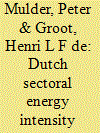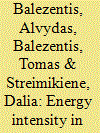| Srl | Item |
| 1 |
ID:
117262


|
|
|
|
|
| Publication |
2013.
|
| Summary/Abstract |
This paper makes use of a new dataset to investigate energy intensity developments in the Netherlands over the period 1987-2005. The dataset allows for a comparison with 18 other OECD countries. A key feature of our analysis is that we combine a cross-country perspective with a high level of sectoral detail, covering 49 sectors. Particularly innovative is our evaluation of energy intensity developments in a wide range of Service sectors. We find that across sectors, energy intensity levels in the Netherlands on average decreased only marginally, and increased in Services. This performance is in general worse than the OECD average, especially between 1987 and 1995. Changes in the sectoral composition of the economy play an important role in explaining aggregate trends. In the Manufacturing sector, about half of the efficiency improvements were undone by a shift towards a more energy-intensive industry structure. In contrast, in the Service sector efficiency decreased, which was undone for about one third by a shift towards a less energy-intensive sector structure.
|
|
|
|
|
|
|
|
|
|
|
|
|
|
|
|
| 2 |
ID:
110425


|
|
|
|
|
| Publication |
2011.
|
| Summary/Abstract |
The measurement, assessment, and effective mitigation of energy intensity compose a foremost objective of contemporary energy policy. Although the European Union (EU) Member States have been experiencing the convergence in energy efficiency indicators, Lithuania, acceded to the EU in 2004, still remains peculiar with relatively high energy intensity. Our study, therefore, is aimed at analyzing the energy intensity trends in Lithuanian economy as a whole as well as in separate economic sectors. The investigation covers the period of 1995-2009. The Logarithmic Mean Divisia Index was applied for decomposition analysis. Our analysis has shown that energy efficiency falls during economic downturn. In order to facilitate these challenges the Lithuanian Government as well as business should opt for increasing energy efficiency in the most problematic sectors of transport and services. In addition, the analysis of legal acts, namely National Energy Efficiency Programme for 2006-2010 and Energy Efficiency Action plan for 2010-2016, was taken into consideration. Some suggestions, thus, were offered for successful implementation of strategic goals outlined in the aforementioned strategic documents.
|
|
|
|
|
|
|
|
|
|
|
|
|
|
|
|